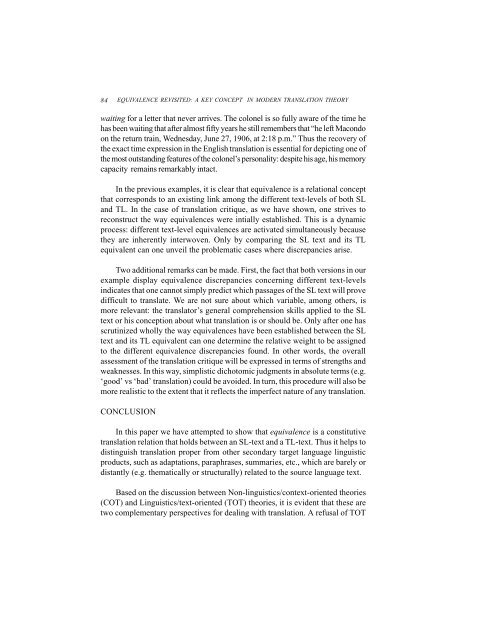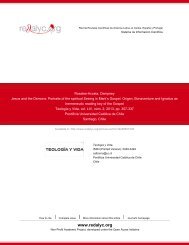A Key Concept in Modern Translation Theory - Redalyc
A Key Concept in Modern Translation Theory - Redalyc
A Key Concept in Modern Translation Theory - Redalyc
Create successful ePaper yourself
Turn your PDF publications into a flip-book with our unique Google optimized e-Paper software.
84 EQUIVALENCE REVISITED: A KEY CONCEPT IN MODERN TRANSLATION THEORY<br />
wait<strong>in</strong>g for a letter that never arrives. The colonel is so fully aware of the time he<br />
has been wait<strong>in</strong>g that after almost fifty years he still remembers that “he left Macondo<br />
on the return tra<strong>in</strong>, Wednesday, June 27, 1906, at 2:18 p.m.” Thus the recovery of<br />
the exact time expression <strong>in</strong> the English translation is essential for depict<strong>in</strong>g one of<br />
the most outstand<strong>in</strong>g features of the colonel’s personality: despite his age, his memory<br />
capacity rema<strong>in</strong>s remarkably <strong>in</strong>tact.<br />
In the previous examples, it is clear that equivalence is a relational concept<br />
that corresponds to an exist<strong>in</strong>g l<strong>in</strong>k among the different text-levels of both SL<br />
and TL. In the case of translation critique, as we have shown, one strives to<br />
reconstruct the way equivalences were <strong>in</strong>tially established. This is a dynamic<br />
process: different text-level equivalences are activated simultaneously because<br />
they are <strong>in</strong>herently <strong>in</strong>terwoven. Only by compar<strong>in</strong>g the SL text and its TL<br />
equivalent can one unveil the problematic cases where discrepancies arise.<br />
Two additional remarks can be made. First, the fact that both versions <strong>in</strong> our<br />
example display equivalence discrepancies concern<strong>in</strong>g different text-levels<br />
<strong>in</strong>dicates that one cannot simply predict which passages of the SL text will prove<br />
difficult to translate. We are not sure about which variable, among others, is<br />
more relevant: the translator’s general comprehension skills applied to the SL<br />
text or his conception about what translation is or should be. Only after one has<br />
scrut<strong>in</strong>ized wholly the way equivalences have been established between the SL<br />
text and its TL equivalent can one determ<strong>in</strong>e the relative weight to be assigned<br />
to the different equivalence discrepancies found. In other words, the overall<br />
assessment of the translation critique will be expressed <strong>in</strong> terms of strengths and<br />
weaknesses. In this way, simplistic dichotomic judgments <strong>in</strong> absolute terms (e.g.<br />
‘good’ vs ‘bad’ translation) could be avoided. In turn, this procedure will also be<br />
more realistic to the extent that it reflects the imperfect nature of any translation.<br />
CONCLUSION<br />
In this paper we have attempted to show that equivalence is a constitutive<br />
translation relation that holds between an SL-text and a TL-text. Thus it helps to<br />
dist<strong>in</strong>guish translation proper from other secondary target language l<strong>in</strong>guistic<br />
products, such as adaptations, paraphrases, summaries, etc., which are barely or<br />
distantly (e.g. thematically or structurally) related to the source language text.<br />
Based on the discussion between Non-l<strong>in</strong>guistics/context-oriented theories<br />
(COT) and L<strong>in</strong>guistics/text-oriented (TOT) theories, it is evident that these are<br />
two complementary perspectives for deal<strong>in</strong>g with translation. A refusal of TOT
















